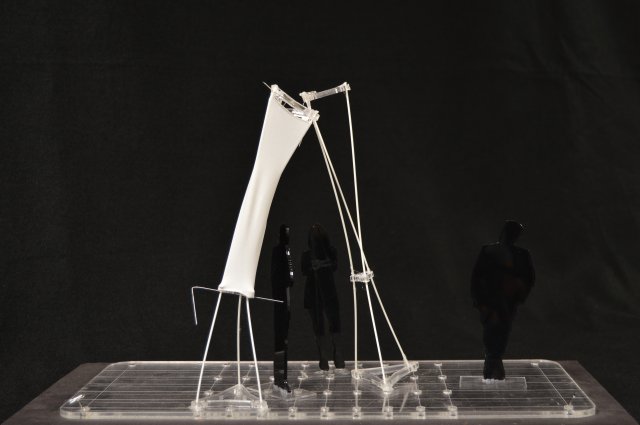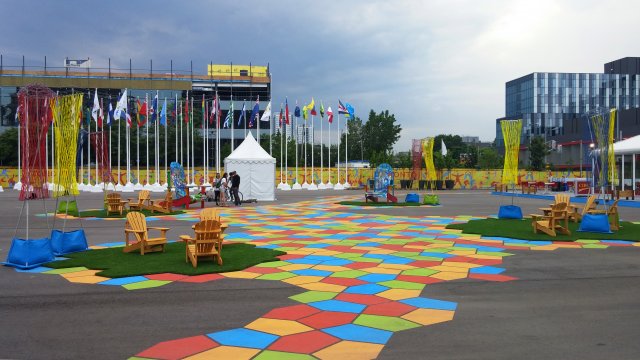Temporality plays a leading role in the design of the Toronto 2015 Pan Am / Parapan Am Games. While international multi-sport events are often associated with large scale permanent projects, such as stadiums and arenas, they are also accompanied by a series of carefully designed temporary spaces and facilities. These transient interventions transform everyday urban spaces such as parking lots and sidewalks into competition venues, cultural centres, and social hubs; addressing the needs of the Games without incurring the considerable costs of permanent facilities. Among the temporary spaces created for Toronto 2015 is
Denegri Bessai Studio’s Panamaze, a colourful intervention that transforms an asphalt surface into the heart of the Athletes Village.
Panamaze is a temporary public space and installation designed for the International Plaza of the Athletes Village at the Toronto 2015 Pan Am / Parapan Am Games. Playful and colourful, this experiment in pop-up placemaking addresses the recreational and social needs of athletes, coaches and volunteers, while providing a fertile ground for material experimentation and architectural innovation.

Created by
Denegri Bessai Studio (DBS), the idea behind this pop-up public space emerged from an adaptive architecture studio led by partner Tom Bessai while guest faculty at the Azrieli School of Architecture & Urbanism at Carleton University. The studio utilized the Pan Am International Plaza as the site to explore innovative technology and design, and allowed Bessai to work closely with the TO2015 Organizing Committee and the Overlay Design team. This fruitful collaboration eventually led to the realization of an actual on-site intervention, with DBS being invited to create Panamaze.
An electrifying geometric pattern of individually painted red, blue, yellow, and green tiles forms a lively urban mosaic for the plaza. The versatile geometry of the pattern – composed of pentagons organized within hexagons – allows the mosaic to thicken and thin as necessary, adjusting easily to site conditions and programming elements. In the heart of the pattern, four grass 'break-out' areas have been created for athletes, coaches and Games volunteers to relax, socialize, and enjoy themselves between events. Dotting the colourful landscape are numerous Muskoka chairs, a playful reference to Canadiana and a key ingredient to the success of this social space.
Punctuating the horizontal mosaic is a series of ephemeral tower structures. Stemming directly from Bessai’s research, the towers are created from flexible and light-weight engineered materials – including GFRP rods, flexible polycarbonate plates, and tensioned nylon cord - bending and swaying in the breeze. Their appearance resembles high performance sporting equipment, from sail masts and riggings to poles for vaulting. They occur in gently leaning pairs to signify friendship and cooperation. Programmatically, the towers act as spatial markers while providing shade. The ballast at the base – originally conceived as the perfect ice box for cold drinks – has been reprogrammed as planters, adding greenery to the landscape.
Together, the combined design elements of Panamaze unify the International Plaza and create a playful and welcoming environment for athletes, coaches and volunteers.

Led by architects Tom Bessai and Maria Denegri, the Panamaze team includes intern architects Duncan Sabiston and Leon Lai, as well as architecture students Hamza Vora, Alexandra Hovis, Artin Sahakian, Stuart Hamre, Laura Fox, Chloe Fratani, along with Brazilian exchange students Savio de Oliveira Nogueira and Luisa Cassol Pasqualotto. Denegri Bessai Studio would also like thank the TO2015 Organizing Committee for their support, including Liza Stiff and Erin Andrews without whom Panamaze would not have been possible.